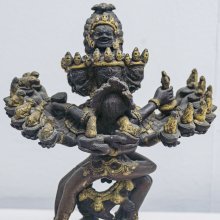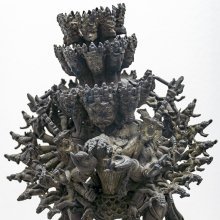Hevajratantra, Hevajra-tantra: 3 definitions
Introduction:
Hevajratantra means something in Buddhism, Pali. If you want to know the exact meaning, history, etymology or English translation of this term then check out the descriptions on this page. Add your comment or reference to a book if you want to contribute to this summary article.
Images (photo gallery)
In Buddhism
Tibetan Buddhism (Vajrayana or tantric Buddhism)
Source: Google Books: Tibetan RenaissanceThe Hevajra-tantra is categorically a siddha production, probably from somewhere in eastern India (Bengal, Bihar, Assam, or Orissa) and was probably written during the late ninth or early tenth century. Also termed the Dvikalpa because of its two ritual sections (kalpa), the Hevajra-tantra was considered a section of the “great Hevajra-tantra” in 500,000 verses, and the identification of a received text as a smaller part of a vast mythic work was a common trope in esoteric writing. Like the Guhyasamāja-tantra and the Cakrasaṃvara-tantra, the Hevajra-tantra is a text at the center of a web of mutually referring and sometimes conflicting scriptures, commentaries, and ritual manuals. Most important for our purposes are two related scriptures, the Saṃpuṭa-tantra and the [Ḍākinī]-Vajrapañjara-tantra, both of which are considered to be the most significant of the many commentarial tantras. The Hevajra-tantra and its various lineages were profoundly influential for renaissance Central Tibetans. They represent a ritual and meditative tradition that became central to both the Sakyapa and the Kagyüpa orders, although the Sakyapa emphasized ti more than any other.
Source: Google Books: Manthanabhairavatantram (tantric buddhism)Hevajratantra (हेवज्रतन्त्र) is Buddhist, it teaches, as do the Buddhist Yoga and Anuttarayoga Tantras in general, practices that have so much in common with those of our text that they can be justifiably regarded as Kaula and their practitioners as Buddhist Kaulas. Thus Snellgrove’s description of the practitioner of the Hevajratantra as he appears in the Tantra can help us to understand how the initiate who observed the outer form of the Vow of Knowledge behaved and what the five insignias (pañcamudrā) were that he wore. [...] The god Hevajra wears the same five insignia that, symbolizing the Five Buddhas of the directions, possess their purifying power.
Source: archive.org: The Indian Buddhist IconographyHevajratantra (हेवज्रतन्त्र) is the name of a book dealing with Buddhist iconography.—Besides the above mentioned Niṣpannayogāvalī, there are numerous Tāntric texts which furnish considerable material for the study of Buddhist iconography of the Tāntric period with which this work primarily concerns itself. Some of the more important materials can be found in the original Tantra works such [viz., Hevajratantra], and many others. [...] Their handwritten copies can be found in the manuscript libraries such as the Durbar Library, Nepal; Asiatic Society’s Library, Bengal; University Library, Cambridge; Musee Guimet, Paris; and the Russian Academy of Sciences in Leningrad. Numerous such manuscripts are also to be found in the hundreds of Buddhist monasteries of Nepal at Kathmandu, Pattan and Bhatgaon.

Tibetan Buddhism includes schools such as Nyingma, Kadampa, Kagyu and Gelug. Their primary canon of literature is divided in two broad categories: The Kangyur, which consists of Buddha’s words, and the Tengyur, which includes commentaries from various sources. Esotericism and tantra techniques (vajrayāna) are collected indepently.
See also (Relevant definitions)
Partial matches: Hevajra, Tantra.
Full-text (+18): Hevajra, Hevajrapindarthatika, Ratnakarashanti, Muktavali, Samdhyabhasha, Saptavarta, Vak Hevajra, Shmashana, Kaya Hevajra, Candali, Samdohaka, Citta Hevajra, Dharmadhatu, Chandoha, Rucaka, Kanthi, Kundala, Shrotapanna, Nagara, Cakri.
Relevant text
Search found 7 books and stories containing Hevajratantra, Hevajra-tantra; (plurals include: Hevajratantras, tantras). You can also click to the full overview containing English textual excerpts. Below are direct links for the most relevant articles:
Blue Annals (deb-ther sngon-po) (by George N. Roerich)
Chapter 10 - Phagmodru Lineage (xi): spyan snga dpal idan bzang po ba < [Book 8 - The famous Dakpo Kagyü (traditions)]
Introduction: The (system) of gcod yul and kha rag pa < [Book 13 - Cutting and Kkarakpa]
Chapter 1 - Master mar pa and Ngok lineage < [Book 8 - The famous Dakpo Kagyü (traditions)]
Guhyagarbha Tantra (with Commentary) (by Gyurme Dorje)
Text 11.28 (Commentary) < [Chapter 11 (Text and Commentary)]
Text 13.16 (Commentary) < [Chapter 13 (Text and Commentary)]
Text 15.17 (Commentary) < [Chapter 15 (Text and Commentary)]
Stupas in Orissa (Study) (by Meenakshi Chauley)
Sahajayana (in Tantric Buddhism) < [Chapter 2]
Uddiyana Pitha (in Tantric Buddhism) < [Chapter 2]
Buddhist Icons as depicted on the Stupas (Introduction) < [Chapter 5]
The Practice Manual of Noble Tārā Kurukullā (by Dharmachakra Translation Committee)
Lakulisha-Pashupata (Philosophy and Practice) (by Geetika Kaw Kher)
A brief insight in Vajrayana Buddhism < [Chapter 2 - Spread and Transition]
The gods of northern Buddhism (by Alice Getty)

